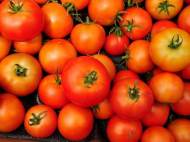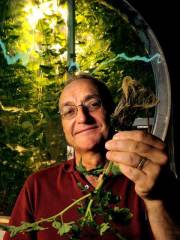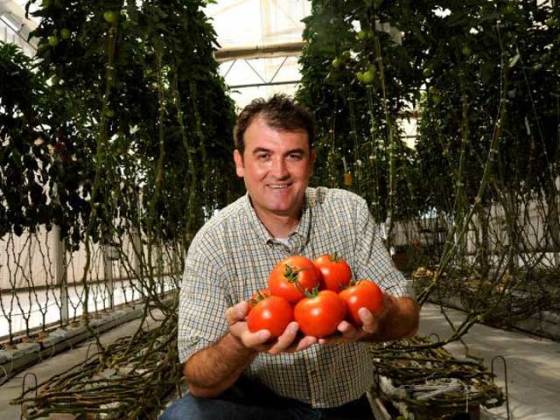Lunar garden enables hydroponic growing of crops
 Researchers at the University of Arizona Controlled Environment Agriculture Center (CEAC) are demonstrating that plants from Earth could be grown hydroponically (without soil) on the moon or Mars, setting the table for astronauts who would find potatoes, peanuts, tomatoes, peppers and other vegetables awaiting their arrival. The technology shows a great potential for application on Earth too.
Researchers at the University of Arizona Controlled Environment Agriculture Center (CEAC) are demonstrating that plants from Earth could be grown hydroponically (without soil) on the moon or Mars, setting the table for astronauts who would find potatoes, peanuts, tomatoes, peppers and other vegetables awaiting their arrival. The technology shows a great potential for application on Earth too.
The research team has built a prototype lunar greenhouse in the CEAC Extreme Climate Lab at UA’s Campus Agricultural Center. It represents the last 5.5 meters (8 feet) of one of several tubular structures that would be part of a proposed lunar base. The tubes would be buried beneath the moon’s surface to protect the plants and astronauts from deadly solar flares, micrometeorites and cosmic rays.
The membrane-covered module can be collapsed to a 1.2-meter (4-foot-wide) disk for interplanetary travel. It contains water-cooled sodium vapor lamps and long envelopes that would be loaded with seeds, ready to sprout hydroponically.
“We can deploy the module and have the water flowing to the lamps in just ten minutes. About 30 days later, you have vegetables”, said Phil Sadler, president of Sadler Machine Co., which designed and built the lunar greenhouse. The UA researchers and Sadler Machine also are collaborating with two Italian firms on this project – Thales Alenia Space (a company that builds hardware for the International Space Station) and Aero Sekur (a company that builds inflatable structures).
Gene Giacomelli, a professor of agricultural and biosystems engineering and a member of the UA’s BIO5 Institute, said that although this robot is built around living green plants (instead of the carbon fiber or steel usually associated with engineering devices) it still requires all the components common to any autonomous robotic system.
These components, which include sensors that gather data, algorithms to analyze that data and a control system to optimize performance, are being designed by assistant professor Roberto Furfaro of systems and industrial engineering, and associate professor Murat Kacira of agricultural and biosystems engineering.
“We want the system to operate itself”, Kacira said. “However, we’re also trying to devise a remote decision-support system that would allow an operator on Earth to intervene. The system can build its own analysis and predictions, but we want to have access to the data and the control system.”
This is similar to the way a CEAC food-production system has been operating at the South Pole for the past six years. The South Pole Growth Chamber, where many ideas which are now used in the lunar greenhouse were developed, was also designed and fabricated by Sadler Machine Co. It provides fresh food to the South Pole research station, which is physically cut off from the outside world for six to eight months each year.
Recycling and efficient use of resources are just as important to the South Pole operation as they will be on the moon. Carbon dioxide is fed into the prototype greenhouse from pressurized tanks, but astronauts could provide CO2 at the lunar base just by breathing. Similarly, water for the plants could be extracted from astronaut urine, and the water-cooled electric lights might be replaced by fiber optic cable (essentially light pipes) which would channel sunlight from the surface to the plants underground.
The lunar greenhouse contains 100 kg (approximately 220 pounds) of wet plant material that can provide 50 liters (53 quarts) of potable water and about 340 grams (0.75 pounds) of oxygen during a 24-hour period, while consuming about 100 kW of electricity and 450 grams (a pound) of carbon dioxide.
The research also could lead to plant colonization in another traditionally hostile environment – large urban centers. One day, we could all use locally grown, fresh food in cities. Aside growing high-quality fresh food, the food would be transported at very short distances, thus reducing the costs and environmental impact of transportation. The technology could also be used to introduce healthy diversity of food which wasn’t grown in the locally available conditions in various parts of Earth, thus enabling agriculture in areas with harsh weather conditions or high altitudes.











Hydroponics (From the Greek words hydro, water and ponos, labor) is a method of growing plants using mineral nutrient solutions, in water, without soil. Terrestrial plants may be grown with their roots in the mineral nutrient solution only or in an inert medium, such as perlite, gravel, mineral wool, or coconut husk.
Researchers discovered in the 19th century that plants absorb essential mineral nutrients as inorganic ions in water. In natural conditions, soil acts as a mineral nutrient reservoir but the soil itself is not essential to plant growth. When the mineral nutrients in the soil dissolve in water, plant roots are able to absorb them. When the required mineral nutrients are introduced into a plant’s water supply artificially, soil is no longer required for the plant to thrive. Almost any terrestrial plant will grow with hydroponics.
Hydroponic vegetables are healthy, vigorous and consistently reliable. Gardening is clean and extremely easy, requiring very little effort.
Techniques
The two main types of hydroponics are solution culture and medium culture. Solution culture does not use a solid medium for the roots, just the nutrient solution. The three main types of solution culture are static solution culture, continuous flow solution culture and aeroponics. The medium culture method has a solid medium for the roots and is named for the type of medium, e.g. sand culture, gravel culture or rockwool culture. There are two main variations for each medium, subirrigation and top irrigation. For all techniques, most hydroponic reservoirs are now built of plastic but other materials have been used including concrete, glass, metal, vegetable solids and wood. The containers should exclude light to prevent algae growth in the nutrient solution.
Static solution culture
In static solution culture, plants are grown in containers of nutrient solution, such as glass Mason jars (typically in-home applications), plastic buckets, tubs or tanks. The solution is usually gently aerated but may be unaerated. If unaerated, the solution level is kept low enough that enough roots are above the solution so they get adequate oxygen. A hole is cut in the lid of the reservoir for each plant. There can be one to many plants per reservoir. Reservoir size can be increased as plant size increases. A homemade system can be constructed from plastic food containers or glass canning jars with aeration provided by an aquarium pump, aquarium airline tubing and aquarium valves. Clear containers are covered with aluminium foil, butcher paper, black plastic or other material to exclude light, thus helping to eliminate the formation of algae. The nutrient solution is either changed on a schedule, such as once per week, or when the concentration drops below a certain level as determined with an electrical conductivity meter. Whenever the solution is depleted below a certain level, either water or fresh nutrient solution is added, A Mariotte’s bottle, or a float valve, can be used to automatically maintain the solution level. In raft solution culture, plants are placed in a sheet of buoyant plastic that is floated on the surface of the nutrient solution. That way, the solution level never drops below the roots.
Continuous flow solution culture
In continuous flow solution culture the nutrient solution constantly flows past the roots. It is much easier to automate than the static solution culture because sampling and adjustments to the temperature and nutrient concentrations can be made in a large storage tank that serves potentially thousands of plants. A popular variation is the nutrient film technique or NFT whereby a very shallow stream of water containing all the dissolved nutrients required for plant growth is recirculated past the bare roots of plants in a watertight thick root mat, which develops in the bottom of the channel, has an upper surface which, although moist, is in the air. Subsequently, there is an abundant supply of oxygen to the roots of the plants. A properly designed NFT system is based on using the right channel slope, the right flow rate and the right channel length. The main advantage of the NFT system over other forms of hydroponics is that the plant roots are exposed to adequate supplies of water, oxygen and nutrients. In all other forms of production there is a conflict between the supply of these requirements, since excessive or deficient amounts of one results in an imbalance of one or both of the others. NFT, because of its design, provides a system where all three requirements for healthy plant growth can be met at the same time, providing the simple concept of NFT is always remembered and practised. The result of these advantages is that higher yields of high quality produce are obtained over an extended period of cropping. A downside of NFT is that it has very little buffering against interruptions in the flow e.g. power outages, but overall, it is probably one of the more productive techniques.
The same design characteristics apply to all conventional NFT systems. While slopes along channels of 1:100 have been recommended, in practice it is difficult to build a base for channels that is sufficiently true to enable nutrient films to flow without ponding in locally depressed areas. Consequently, it is recommended that slopes of 1:30 to 1:40 are used. This allows for minor irregularities in the surface but, even with these slopes, ponding and waterlogging may occur. The slope may be provided by the floor, or benches or racks may hold the channels and provide the required slope. Both methods are used and depend on local requirements, often determined by the site and crop requirements.
As a general guide, flow rates for each gully should be 1 liter per minute. At planting, rates may be half this and the upper limit of 2L/min appears about the maximum. Flow rates beyond these extremes are often associated with nutritional problems. Depressed growth rates of many crops have been observed when channels exceed 12 metres in length. On rapidly growing crops, tests have indicated that, while oxygen levels remain adequate, nitrogen may be depleted over the length of the gully. Consequently, channel length should not exceed 10–15 metres. In situations where this is not possible, the reductions in growth can be eliminated by placing another nutrient feed half way along the gully and reducing flow rates to 1L/min through each outlet.
Some of the reasons why hydroponics is being adapted around the world for food production are the following:
•No soil is needed
•The water stays in the system and can be reused- thus, lower water costs
•It is possible to control the nutrition levels in their entirety- thus, lower nutrition costs
•No nutrition pollution is released into the environment because of the controlled system
•Stable and high yields
•Pests and diseases are easier to get rid of than in soil because of the container’s mobility
Today, hydroponics is an established branch of agronomy. Progress has been rapid, and results obtained in various countries have proved it to be thoroughly practical and to have very definite advantages over conventional methods of horticulture. The two chief merits of the soil-less cultivation of plants are, first, much higher crop yields, and second, hydroponics can be used in places where in-ground agriculture or gardening is not possible(Source: Wikipedia).
In developing countries Hydroponics can be promoted on a massive scale to provide nutritious vegetables and fruits. This will provide livelihood also to local people.
Dr.A.Jagadeesh Nellore (AP), India